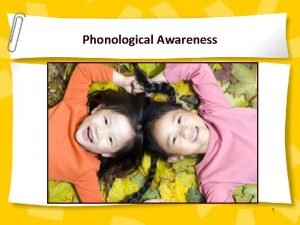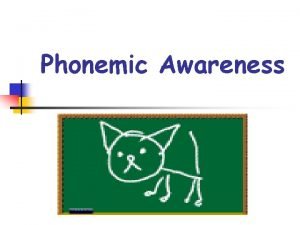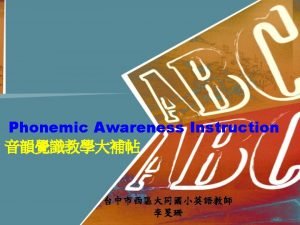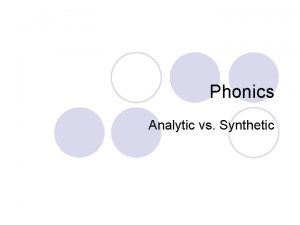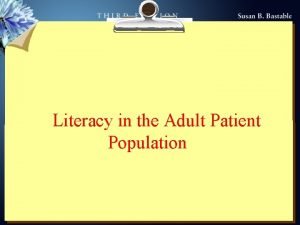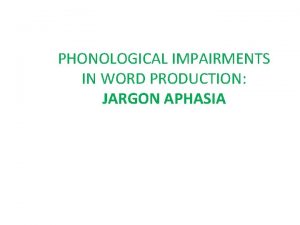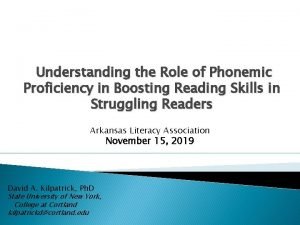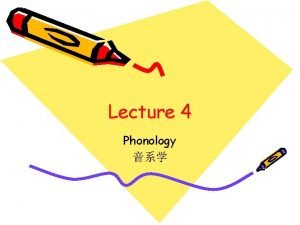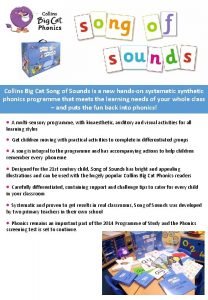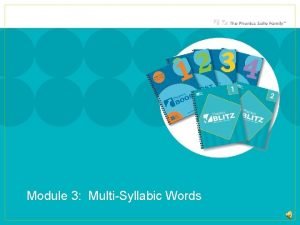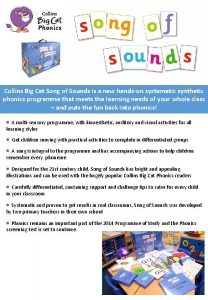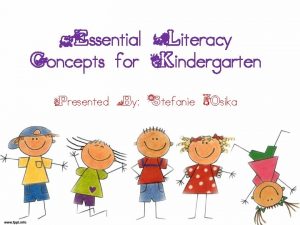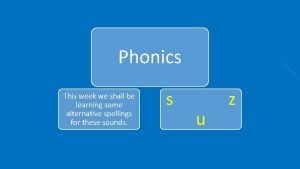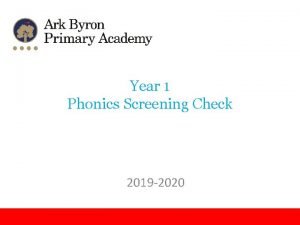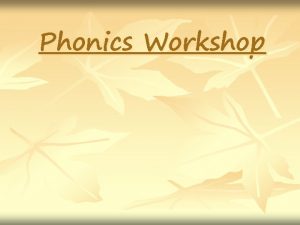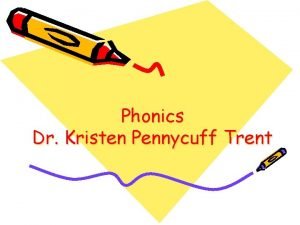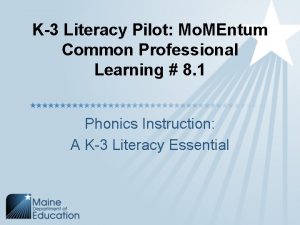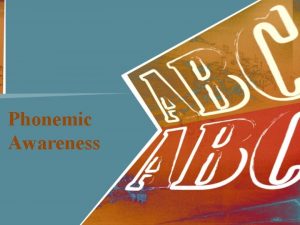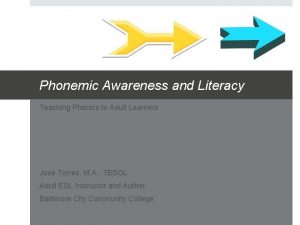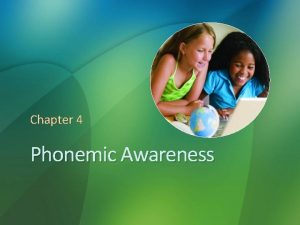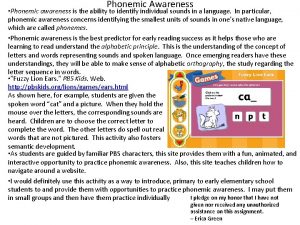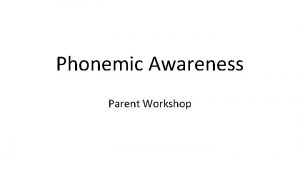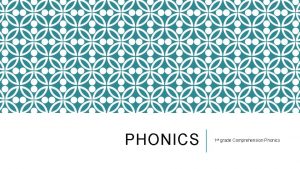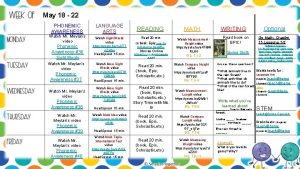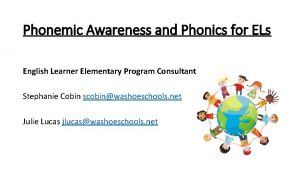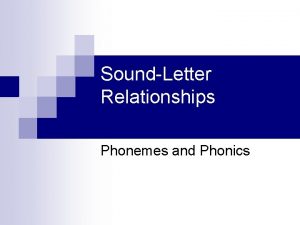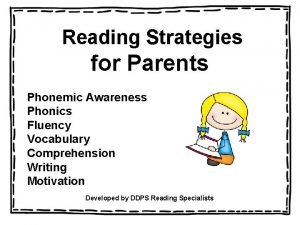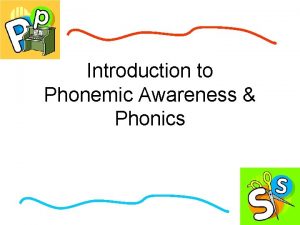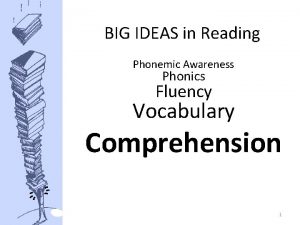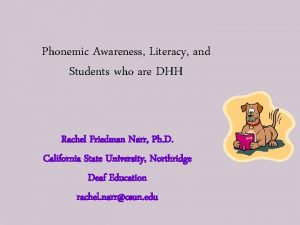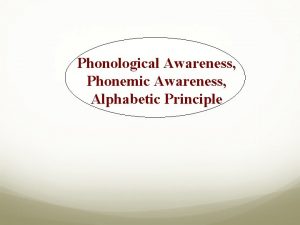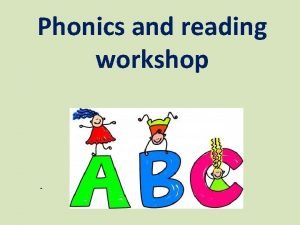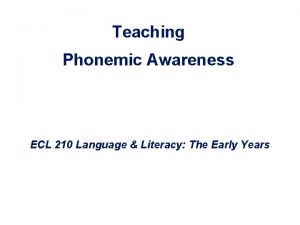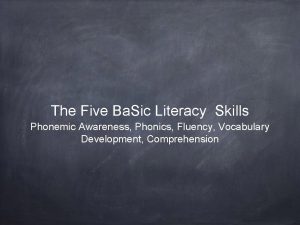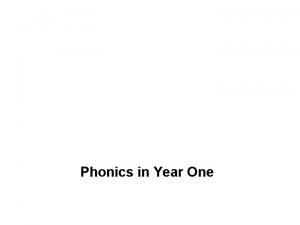Phonemic Awareness and Literacy Using Phonics with Adult





























- Slides: 29

Phonemic Awareness and Literacy: Using Phonics with Adult ELLs Teaching Phonics to Secondary and Adult Learners Jose Torres, M. A. , TESOL Teacher and Author Baltimore City Public Schools Baltimore City Community College

Overview ∗ Understanding the connection between phonological awareness, phonics, phonemic awareness and literacy ∗ The impact of relevant data ∗ The concept of “Swing Differentiation” ∗ The importance of “listening” to students ∗ How to use phonics based assessments to drive instruction

What is the relation between phonics and phonemic awareness? First, what’s the difference?

Phonics Vs. Phonemic Awareness ∗ “Phonics involves the relationship between sounds and written symbols, whereas phonemic awareness involves sounds in spoken words. Therefore, phonics instruction focuses on teaching sound-spelling relationships and is associated with print. Most phonemic awareness tasks are oral. ” (from scholastic. com)

The Sandwich of Literacy ∗ ∗ Phonological Awareness Phonics Phonemic Awareness Literacy

Identifying Characteristics Phonics Phonological Awareness • • • Hear sounds Recognize words that rhyme Identifying beginning sounds Understanding sounds can be manipulated Separating words into their sounds • • 6 Relationships between letters and sounds Written words are composed of letter patterns representing sounds

What the experts say… ∗ “. . . perhaps the most important single conclusion about reading disabilities is that they are most commonly caused by weaknesses in the ability to process the phonological features of language. ” (Torgesen et al. , 1999, p. 579) ∗ “To my mind, the discovery and documentation of the importance of phonemic awareness. . . is the single most powerful advance in the science and pedagogy of reading this century. ” (Adams, 1990)

Why phonemic awareness is important in literacy… ∗ “It requires readers to notice how letters represent sounds. It primes readers for print. ” (University of Oregon) ∗ “It focuses on the phonemes, which are the units of sound that correspond with the letters of the alphabet. ” (Chappell et al. , 2009) ∗ Teaching phonemic awareness to students is important because it helps with the alphabetic principal. ” (Manyak, 2008)

The significance of Phonics for Adults ∗ Increases phonological awareness, hence phonemic awareness ∗ Improves students’ abilities to distinguish individual sounds in listening, which helps them in articulation ∗ Engages students at the phonetic level which often helps with class retention ∗ Ultimately helps improve outcome (assessment) scores significantly

The Inconvenient Truth ∗ Kennedy and Walters (2013) found only 40% of adults in ESL classes improve their proficiency levels ∗ “…there is a broad consensus among academics that very limited scientifically based research has been conducted to identify effective approaches to adult English language instruction. ” (GAO 2009) ∗ “…there is no experimental or quasi-experimental research in adult literacy that strongly supports implicit or explicit approaches to teaching language and literacy skills. ” (Cronen, Silver-Pacuilla & Condelli, 2004)

Research findings ∗ From 2011 to 2016, hundreds of students participated in classes with phonics instruction infused with contextualized instruction ∗ 85. 6% of low beginner level students who received phonics infused instruction increased their proficiency levels ∗ Of those that earned a 60 or better on their phonics assessments, 94. 5% increased their proficiency levels and moved on to the next class level Source: Independent Report, Baltimore City Community College in Baltimore, Maryland. Peer review pending.

Teaching Phonics is a ∗ Latin based alphabet systems have different pronunciations of the same letters ∗ Non-Latin based alphabet systems have entirely different symbol-sound systems ∗ Starting at the beginning, with identifying letters and their sounds is a step in the language acquisition process, especially with regards to literacy ∗ A good place to start is with differentiating long and short vowels

∗ Differentiating between long and short vowels (and subsequently the silent e and how it influences the pronunciation of certain words): Examples. . . Hat Hate Rate

More Examples ∗ The number “Six” comes from the Latin word “Sex. ” In Spanish and Portuguese it’s “Seis, ” which is pronounced with the long a /sās/. Therefore, differentiating the long and short vowels helps students make some crucial distinctions, like what /ā/ sounds like and what a short i sounds like. ∗ It becomes apparent that many words have general patterns in their pronunciations and over time, these patterns can be emphasized in small, but significant chunks.

What phonetic elements are most problematic for secondary level ELLs? ∗ ∗ ∗ Vowels Digraphs Consonant Blends Diphthongs These are problematic especially at the beginning levels because they hinder the comprehension process. The comprehension process is hindered because students have trouble articulating particular words, and thus have difficulty understanding them when they are heard. They make the connections when they are read and meaning is attached.

What do you do when a group of students in a class are at different proficiency levels?

The Strategy “Swing Differentiation” ∗ “Swing Differentiation” is an approach that adopts a general goal for all students in a given group that may have significant variations in proficiency levels. ∗ ELLs in a group have common phonological gaps that can be targeted. ∗ These common needs encompass a common goal. When everyone is working toward the same goal, there can be greater unification and ultimately collaboration among the groups.

So, how do you know what to target for the group?

Listening is CRUCIAL ∗ One of the most important tools you have as ESL instructors is your ability to determine students’ needs based on what you hear. Do you know what to listen for? ∗ Being an active listener will help guide your instruction as you tailor your lessons to emphasize what your students really need to work on. ∗ Listen for what students are saying both in read-a-louds and when answering general questions. How they are pronouncing words and forming sentences tells you a great deal about their phonemic awareness.

Let’s go back to that question: Do you know what to listen for? Listen to some examples of real students and rate their ability to articulate. Can you determine what they need? ∗ Listen for the emphasis on long and short vowel in their pronunciations. ∗ What do you think this means? ∗ How well did these students pronounce their “th” sounds? ∗ What does this tell you about the students? ∗ And what might you do to help these students with their speaking skills?

Handout: Rubric. ∗ Look over the rubric for a minute. You are about to listen to some examples. Use the rubric to help you determine how to rate the students based on their articulation. ∗ Turn to others in your table and discuss for a minute if you assess students similarly.

Look at the rubric provided and listen to examples 1, 2 and 3. Example 1 Example 2 Example 3 What do you hear? What did you notice about vowel pronunciation? What sounds/words are challenging in the example? How would you describe the overall reading fluency of each speaker?

What the experts think… ∗ Example 1: Both the male student and female student scored 7 for their oral presentation. ∗ Example 2: The male student scored 5; the female scored 2. ∗ Example 3: Both female students scored 6. ∗ Again, refer to the rubric to see how students are scored.

Last questions for giveaway prizes:

Question 1 ∗ What is the difference between phonological awareness and phonemic awareness?

Question 2 ∗ Explain the concept of “Swing Differentiation. ”

Contact info and more ∗ ∗ ∗ ∗ Jose Vasilio Torres Email: iwanttolearnenglish 3@gmail. com Twitter: @iwtle 3 Phone: 443 -743 -5851 Website: www. iwtle. com Name of textbook: I Want To Learn English ISBN-13: 978 -1523847549 ISBN-10: 1523847549

References ∗ Torgesen, J. , Wagner, R. , Rashotte, C. , Rose, E. , Lindamood, P. , Conway, T. , & Garvan, C. (1999). Preventing reading failure in young children with phonological disabilities: Group and individual responses to instruction. Journal of Educational Psychology, Vol 91 (4), 579 -593. ∗ University of Oregon http: //reading. uoregon. edu/big_ideas/pa/pa_what. php ∗ Chappell, J. C. , Stephens, T. L. , Kinnison, L. , & Pettigrew, J. D. (2009). Educational diagnosticians' understanding of phonological awareness, phonemic awareness, and reading fluency. Assessment for Effective Intervention, 35(1), 24 -33. ∗ Manyak, P. C. (2008). Phonemes in use: Multiple activities for a critical process. Reading Teacher, 61(8), 659 -662. doi: 10. 1598/RT. 61. 8. 8

References Continued… ∗ Adams, M. J. (1990). Beginning to read: Thinking and learning about print. Cambridge, MA: MIT Press. ∗ Belvins, W. Understanding Phonics. Scholastic. Retrieved from http: //www. scholastic. com/teachers/article/understanding-phonics
 Phonemic awareness continuum
Phonemic awareness continuum Phonemic awareness definition
Phonemic awareness definition Prephonemic stage
Prephonemic stage Language flashcards
Language flashcards Word wall vs sound wall
Word wall vs sound wall Phonemic awareness ppt
Phonemic awareness ppt Phonemic awareness
Phonemic awareness Phonemic awareness
Phonemic awareness Phonemic awareness, sioux falls
Phonemic awareness, sioux falls Synthetic and analytic phonics
Synthetic and analytic phonics Privacy awareness and hipaa privacy training cvs answers
Privacy awareness and hipaa privacy training cvs answers Iloralacy
Iloralacy Erik jacobson montclair state university
Erik jacobson montclair state university Venn diagram media information and technology literacy
Venn diagram media information and technology literacy Site:slidetodoc.com
Site:slidetodoc.com Differentiate people as media and people in media.
Differentiate people as media and people in media. Cyber literacy for the digital age
Cyber literacy for the digital age Allophone
Allophone Phonemic jargon
Phonemic jargon Phonemic proficiency definition
Phonemic proficiency definition Phonemic transcription
Phonemic transcription Cat song
Cat song Phonics blitz online
Phonics blitz online Cat song
Cat song Fountas and pinnell phonics kindergarten
Fountas and pinnell phonics kindergarten Phonics play obb and bob
Phonics play obb and bob 2019 phonics screening test
2019 phonics screening test The rose report 2006
The rose report 2006 Phonics generalization
Phonics generalization Blending lines phonics
Blending lines phonics
